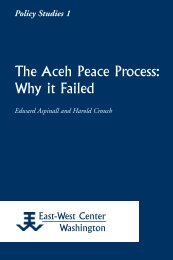Constructing Papuan Nationalism: History, Ethnicity ... - ScholarSpace
Constructing Papuan Nationalism: History, Ethnicity ... - ScholarSpace
Constructing Papuan Nationalism: History, Ethnicity ... - ScholarSpace
- No tags were found...
Create successful ePaper yourself
Turn your PDF publications into a flip-book with our unique Google optimized e-Paper software.
76 Richard ChauvelPART IV – Threat of Partition and Prospects of <strong>Nationalism</strong>The Threat of PartitionDespite the strong and clear expression of <strong>Papuan</strong> identity and demandsfor independence since Suharto, regional diversity and local interests haveremained strong in Papua. The ability of the Presidium to establish aprovince-wide organization in 2000 suggested that the sort of regional differencesdiscussed in the cases of Serui and Fakfak had become less significantthan they had been in the 1960s. The strength of the Presidium’s supportin regions like the highlands, where there had been little participationin the first phase of <strong>Papuan</strong> nationalism in theearly 1960s, gave the impression that <strong>Papuan</strong>identity had spread and consolidated underIndonesian rule, not least as a <strong>Papuan</strong> response toIndonesia’s heavy reliance on violence to maintainits authority in the province. However,though this was true, the pattern of <strong>Papuan</strong> politics since the central government’sdecision in early 2003 to divide the province indicates that local,regional and ethno-linguistic differences are still critical.The decision to divide the province actually preceded the enactmentof the Special Autonomy Law of 2001. In 1999, partly in response to the“Team 100’s” demand for independence, the Indonesian government hadenacted Law 45/99 (UU 45/99), which created additional provinces anddistricts in Papua, claiming that doing so would enable the government toimprove the provision of services across the territory. The law’s promulgationsparked widespread protests in Papua, and in response the governmentbacked off from implementing the law, which most of the <strong>Papuan</strong>elite later assumed had been superseded by the Special Autonomy Law of2001 (21/2001) (see Chauvel and Ikrar Nusa Bhakti 2004: 37–39;McGibbon 2004a: 10–11). However, the law was never formally revoked,and by late 2002 <strong>Papuan</strong> legislators seemed aware that President Megawatiwas contemplating a new effort at implementation. Again they attemptedto oppose the move (Chauvel and Ikrar Nusa Bhakti 2004: 37), but thistime they did so to no avail, for in January 2003 Megawati issued aninstruction (Inpres 1/2003) to accelerate the implementation of the 1999Law (UU 45/99), thereby creating the new provinces of West Irian Jayaand Central Irian Jaya (the easternmost province, administered fromregional diversity andlocal interests haveremained strong
















